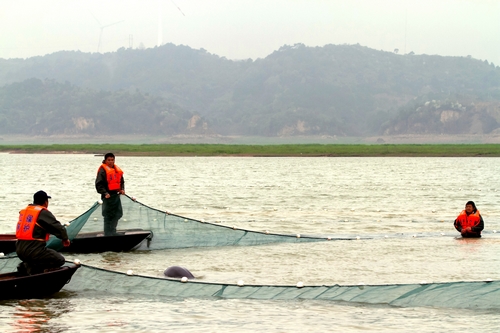
Newsroom
Milestone in Race to Save Species Ten Years from Extinction

Chinese scientists and local fishermen during a translocation exercise for finless porpoises in the Yangtze River, China. ? WWF / Li Kui
Jianli, China – Four Yangtze finless porpoises were released into their new home today, marking the start of an ambitious translocation project to help save the critically endangered species from extinction.
The finless porpoises – part of an estimated population of just 1000 – were captured in Poyang Lake in eastern China before being safely moved 400 km to the He-wang-miao/Ji-cheng-yuan oxbow, where they will start a new population.
Four other finless porpoises from Poyang Lake are also being translocated to the Tian-e-zhou oxbow to boost the genetic diversity of its small population.
"Based on current numbers and rate of decline, the Yangtze finless porpoise will likely be extinct in the next 5-10 years,” said Dr Wang Ding, Researcher at the Institution of Hydrobiology (IHB) of the Chinese Academy of Science, which is leading the translocation project. “To prevent the finless porpoise from suffering the same fate as the Baiji Dolphin, which is now extinct in the Yangtze River, we must focus on translocation, while also working to conserve the porpoise’s natural habitat.”
Since 2002, WWF has worked with the Ministry of Agriculture (MOA), the IHB and other partners to conserve the finless porpoise. WWF played a role in selecting, studying and preparing the new site as well as training the staff. WWF also organized a survey of the finless porpoise.
"It is an honor to witness this historic moment because by conserving the finless porpoise, we are also helping to conserve the ecosystem of the Yangtze River,” said Lu Sze Ping, WWF China CEO. “WWF has been working with the government and partners for years to protect and enlarge finless porpoise habitats along the Yangtze, and we welcome the creation of this new population.”
A thriving new population is critical to the species’ survival because its numbers are falling by up to 13.7% per year due to the environmental impact of human activities along the Yangtze including shipping, sand mining, pollution, illegal fishing and water projects.
With the species swiftly disappearing, the MOA launched a new conservation plan for the finless porpoise last October, which included translocation as a critical component.
"The fishery department and research institutions have enhanced conservation activities in the wild as well as improving the artificial breeding technology but finless porpoise numbers are still falling,” said Yu Kangzhen, MOA Vice Minister. “While we continue this important work, translocating some finless porpoises to a new home will help give the species a chance to survive and thrive.”
The omens for success are good following the success of a previous translocation in the 1990s. Under the leadership of the MOA, finless porpoises were successfully translocated to a new reserve in the Tian-e-zhou oxbow.
Over the next 20 years, while finless porpoise numbers plummeted in the main river, the population in the Tian-e-zhou oxbow slowly increased to 45, with up to six babies now born each year. But the oxbow is approaching its carrying capacity, another reason why the new porpoise expansion site is so vital and timely.
The He-wang-miao/Ji-cheng-yuan oxbow is home to 34 fish species and boasts good quality water and the right environmental conditions for the porpoises.
The oxbow has been divided into separate zones. All fishing activities have been prohibited in the 16.6 km2 core area, which boasts the most suitable habit for the porpoise and is separated from the buffer zone by security fences. While some fishing activities will be allowed in the buffer zone, WWF has been working with local authorities to draw up a plan to provide technical and financial support to help local fishermen develop alternative livelihoods.
"The survival of this new population of Yangtze finless porpoises depends on the support and involvement of the local communities,” said Lei Gang, WWF Yangtze programme senior director. “By helping fishermen to develop new ways of providing for their families, WWF and the local authorities are ensuring that the translocation will benefit both porpoises and people.”
This week’s translocation is the first step in a long process with hopes that the He-wang-miao/Ji-cheng-yuan oxbow could eventually be home to 100 Yangtze finless porpoises. Together with Tian-e-zhou oxbow, the new site will form part of a network of finless porpoise reserves that will not only protect viable populations but also allow individuals to be exchanged between them to maintain the species’ overall genetic diversity.
"Conserving this beautiful species is not an overnight task but we hope that today’s milestone will mark the start of a bright new chapter for the finless porpoise and a healthier Yangtze,” said Malini Thadani, Head of Corporate Sustainability, Asia Pacific at HSBC, which has supported WWF’s work along the Yangtze for over a decade. (WWF)